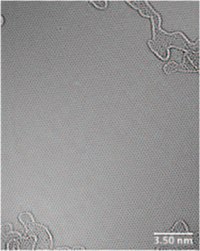Graphene in Biotechnology
Alba Centeno, Amaia Zurutuza Elorza
Graphenea S.A. Tolosa Hiribidea, 76, E-20018 Donostia - San Sebastian, Spain
Material Matters™, 2013, 8.1
Material Matters™ Publications
Graphene Technology
Graphene has emerged as the new wonder material. Being only one atom thick and composed of carbon atoms arranged in a hexagonal honeycomb lattice structure, the interest in this material has exploded exponentially since 2004 when it was first isolated and identified using a very simple method.1
Graphene is the building block for carbon nanomaterials with different dimensionalities (Figure 1). For example, if graphene is wrapped up into a ball, a 0D fullerene is obtained; when rolled, a 1D nanotube; and if stacked, a 3D graphite is obtained.
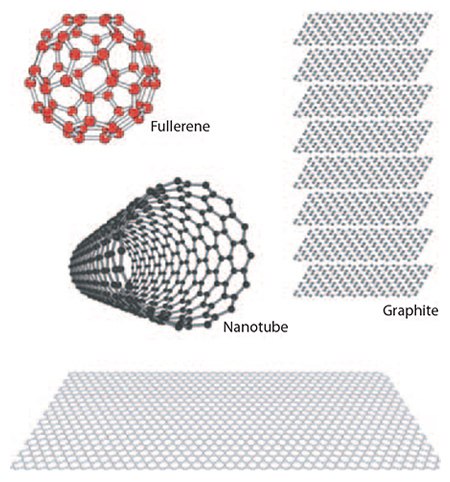
Figure 1.Graphene is the building block for other carbon materials.
The carbon atoms in graphene exhibit sp2 hybridization and this hybridization together with the atomic thickness (0.345 nm), give this unique material extraordinary properties, such as: extremely high electron and hole mobility values (>105 cm2V-1s-1) even at room temperature;2 very high thermal conductivity (>4,000 Wm-1K-1) at room temperature;3 2.3% of light absorbance over a wide range of the visible spectrum;4 mechanical strength 300 times higher than steel with a Young′s modulus of 1 TPa (when compared to steel with the same thickness);5 and an impermeability to gases, including helium.6 It is expected graphene will find application in many different fields such as electronics, optoelectronics, energy (solar, batteries, supercapacitors), touch screen and display technology, lighting, and composites.
Moreover, graphene and its derivatives have a great potential for biomedical applications since their properties (such as high surface area, tailor-made functionality, and a large sp2 hybridization surface) provide excellent biocompatibility, physiological solubility, stability, and capability of loading or conjugating different types of compounds. Table 1 summarizes the advantages of graphene and suitable forms in biotechnology applications. It is important to note graphene can be synthesized in two different forms: 1) film via chemical vapor deposition (CVD); and 2) powder via chemical exfoliation: graphene oxide (GO) and reduced graphene oxide (rGO). Depending on the form, the properties of the graphene will vary.
Graphene in Biomedical Applications
Molecules, biomolecules, quantum dots, polymers, and even nanoparticles could be loaded/conjugated onto graphene-based carriers (Figure 2). The loading could be achieved via covalent bonding or non-covalent interactions; e.g., hydrogen bonding, hydrophobic, π–π stacking, and electrostatic interactions.
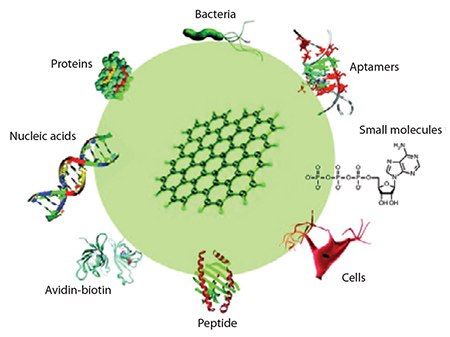
Figure 2.Biofunctionalization of graphene and its derivatives.7 Reprinted with permission from Elsevier.
Graphene Oxide in Drug and Gene Delivery
Graphene and its derivatives are the latest materials to be designed for drug and gene delivery applications, including targeted delivery. The ability to load both water-soluble and insoluble active compounds, and attach different targeting moieties onto graphene oxide (GO) platelets could enable their use in targeted or non-targeted drug and gene delivery applications.
Functionalization of the GO platelets is extremely important to improve biocompatibility and solubility of graphene, and also to achieve successful targeted delivery and diverse therapeutic treatments. The most common strategy for the chemical modification of the GO platelets is covalent attachment of polymers. Many different polymeric moieties have been successfully grafted onto GO, including polyethylene glycol (PEG, Product No. 81300), chitosan (Product No. 448869) and polyethyleneimine (PEI, Product No. 482595). In addition to polymers, biotargeting ligands, DNA, proteins, bacteria, cells, quantum dots, and nanoparticles have also been grafted onto graphene and its derivatives. Therefore, the structural features and ease of chemical modification make GO a very versatile platform for biomedical applications.
Since many pharmaceutically active compounds contain aromatic groups, they could be stabilized via π-π interactions with graphene. For example, doxorubicin (DOX), an anticancer drug, was loaded via π–π stacking onto PEGylated nano-GO (NGO) (lateral dimensions <10 nm) functionalized with an antibody for in vitro targeted drug delivery.8
In order to enhance anticancer efficiency and target tumor tissues and associated cells, a dual-targeting drug delivery system based on a multifunctionalized GO was developed.9 The GO was functionalized with folic acid (FA) molecules for molecular targeting and magnetic iron oxide (Fe3O4) nanoparticles (Product No. 725331) for magnetic targeting. First, the (3-aminopropyl)triethoxysilane (APS) (Product No. 741442) modified superparamagnetic GO-Fe3O4 nanohybrids were prepared, followed by conjugation of FA onto the Fe3O4 nanoparticles via imide linkages between the amino groups of the APS and the carboxylic groups of the FA. In the final step, DOX was loaded onto these multifunctionalized carriers via π–π stacking, shown in Figure 3. Fluorescein isothiocyanate (FITC, Product No. F7250) was used for labeling. The results indicated the potential of these multifunctional GO-based carriers for the targeted delivery and controlled release of anticancer drugs. In addition, the DOX release could be controlled by pH conditions in the surrounding environment.
Alternatively, photothermal treatment could be combined with anticancer drugs to improve the therapeutic efficacy.10 Photothermal therapy with DOX-loaded PEGylated NGO was tested in vivo in a preclinical mouse model. The combination of photothermal therapy and chemotherapy significantly improved the efficacy of cancer treatment in comparison with either therapy alone. In a second in vivo study, the DOX was loaded onto GO-based carriers that included a molecular targeting moiety (FA-modified ß-cyclodextrin).11 In both studies, the functionalized GO drug delivery systems performed better than DOX alone in vivo due to better efficacy and reduced number of side effects, which in turn led to an improved mortality rate. In a recent study, a combination of magnetically targeted drug delivery, photothermal therapy, and magnetic resonance imaging (MRI) was investigated.12
One major challenge facing gene delivery is the development of a safe gene vector that protects DNA from degradation and enables cellular uptake of DNA with high efficiency. Recent studies have revealed PEImodified GO not only significantly lowered the cytotoxicity of PEI, but also improved its transfection efficiency for efficient DNA delivery.13,14 Furthermore, in one of the studies, DNA could be delivered into the cell nucleus, as evidenced by intracellular tracking of the reporter gene.14
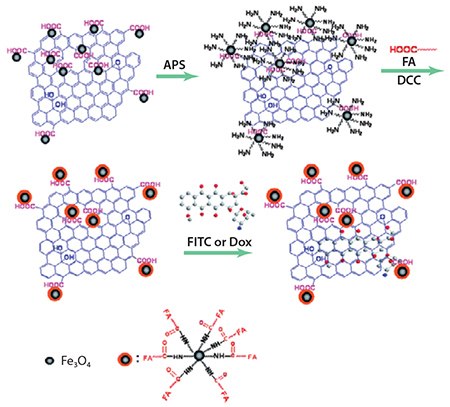
Figure 3.Multifunctional GO based carrier.9 Reproduced by permission of The Royal Society of Chemistry.
Graphene Films, Graphene Oxide, and Reduced Graphene Oxide in Tissue Engineering
Tissue engineering relies on the design of biocompatible scaffolds with suitable physical, chemical, and mechanical properties. Graphene and its derivatives are of interest as scaffold materials due to their inherent elasticity, flexibility, high surface area, adaptability, and functionality. GO and rGO, in the form of thin films, were shown to be appropriate scaffolds for the growth of mammalian fibroblast cells since they display good biocompatibility as a surface coating material, without inducing notable detrimental effects while enhancing some cellular functions such as gene transfection and expression.15
Furthermore, growth and proliferation of human stem cells have been observed on various graphene-coated platforms.16 Single-layer graphene grown via CVD was transferred onto polydimethyl siloxane (PDMS) (Product Nos. 761028 and 761036), polyethylene terephthalate (PET), glass, and silicon/silicon dioxide (Si/SiO2) platforms. Graphene was found to be a very promising biocompatible scaffold, regardless of the underlying platform, that promoted the proliferation of human mesenchymal stem cells (hMSCs) and accelerated their specific differentiation into bone cells. Figure 4A. Depicts a CVD graphene film that has been transferred onto a Si/SiO2 platform. Bone cell formation, indicated by specific immunostaining for osteocalcin (OCN), occurred only on the graphene film while no bone cells were formed on the Si/SiO2 platform (Figure 4B). Alizarin red staining indicates the presence or absence of calcium deposits due to bone nodule formation and can be used for quantitative measurements. Quantification of results is shown in Figures 4C and 4D, where the extent of calcium deposition on the various scaffolds was compared. Calcium deposition was found to be greatest on graphene films, independent of the platform, and even in the absence of the growth factor BMP-2. In order to confirm these results, the effect to induce bone cell differentiation of graphene and BMP-2 were compared. In the absence of both graphene and BMP-2, no bone nodule formation was detected (Figure 4E) since negative alizarin red staining was obtained. With the addition of BMP-2, positive staining was observed (Figure 4G). Graphene-coated PET also showed positive staining, even in the absence of BMP-2 (Figure 4F). Positive staining was also obtained in the presence of both BMP-2 and graphene (Figure 4H). Remarkably, graphene accelerated cell differentiation, even in the absence of commonly used growth factors. Therefore, the incorporation of graphene films in implants or injured tissues would not affect the physiological conditions of the surrounding microenvironment.16
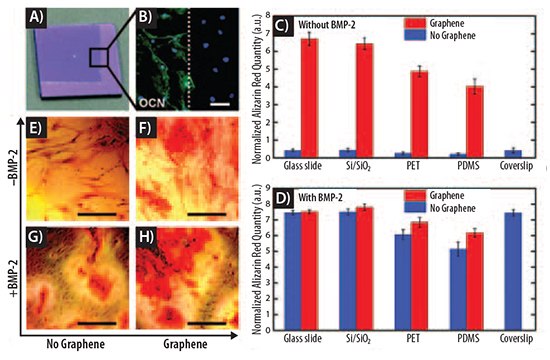
Figure 4.Graphene accelerates bone cell differentiation. A) Optical image of CVD graphene on Si/SiO2, showing the graphene boundary. B) OCN marker indicates bone cell formation only on the graphene area. C) Cells grown in the absence of BMP-2. D) Cells grown in the presence of BMP-2. E-H) PET substrate stained with alizarin red reveal calcium deposits due to osteogenesis. E) PET without BMP-2 and without graphene. F) PET without BMP-2 and with graphene. G) PET with BMP-2 and without graphene. H) PET with both BMP-2 and graphene. Scale bars 100 μm. Reprinted with permission from reference 16. Copyright 2011 American Chemical Society.
Graphene films produced via CVD were found to enhance differentiation of human neural stem cells to neurons (hNSCs) rather than glials.17 The hNSCs adhered to graphene rather than glass and differentiated mainly into neural cells. These results open up many opportunities for graphene in neuroscience and other fields, including stem cell research and regenerative medicine.
In another study, GO and graphene films produced via CVD were tested in the proliferation and subsequent differentiation of stem cells (hMSCs) into specific tissues.18 Graphene films were found to proliferate and differentiate stem cells (hMSCs) into osteogenic tissue in the presence of osteogenic chemical inducers. GO enhanced adipogenic differentiation of the stem cells. It was found GO and graphene films were effective preconcentration scaffolds for accelerated stem cell growth and differentiation through molecular interactions.18
Graphene Oxide and Reduced Graphene Oxide in Molecular Imaging
GO was used as a fluorescent marker for intracellular imaging studies via optical imaging. PEGylated nano-GO (NGO) was found to be photoluminescent in the visible and infrared regions.8 Intrinsic photoluminescence of GO enabled NIR imaging of lymphoma cells after molecular targeting of the PEGylated NGO. In other reports, fluoresceinfunctionalized PEGylated NGO and gelatin-grafted rGO labeled with rhodamine 6G (fluorescent dye, Product No. 252433) were used for cellular imaging.19,20 In both cases, the PEG and gelatin linkers prevented GO and rGO from quenching the conjugated fluorescein and rhodamine, respectively.
rGO-based quantum dots were tested as intracellular fluorescent probes in human carcinoma cells (MG-63, HeLa, Product No. 86051601).21-23 These materials were prepared either via a one-step solvothermal method starting from GO21 or rGO conjugated with quantum dots (QDs) using a bridge of bovine serum albumin (BSA, Product No. A7888),22 or PEG and FA as the molecular targeting moiety.23 The nanocomposites combined the capability of cell tumor bioimaging and photothermal therapy since they could absorb NIR irradiation, as demonstrated by in vitro and in vivo studies. The integration of these functionalities could open up excellent opportunities in cancer diagnosis, imaging, and treatment combined.
Even though most of the reported optical imaging studies were carried out in vitro, a few in vivo studies have been described. PEGylated NGO (lateral dimensions 10-50 nm) was conjugated with a NIR fluorescent dye for in vivo fluorescence imaging followed by photothermal therapy in mouse tumor models.24 The results show highly efficient tumor passive targeting and relatively low retention in the reticuloendothelial system. No noticeable toxicity effects were detected in the mice. PEGylated NGO was found to have very good biocompatibility.
PEG and dextran-coated iron oxide-GO nanocomposites as T2 contrast agents in vivo and in vitro MRI studies, respectively, were reported.12,25 The in vivo study showed PEG-coated iron oxide-GO nanoparticles accumulated in tumor and liver areas.12 High uptake by the tumor was attributed to the enhanced permeability and retention effect of cancerous tumors. Compared to iron oxide nanoparticles alone, the nanocomposite materials exhibited enhanced cellular MRI imaging performance.25
Positron emission tomography (PET) is a very sensitive imaging technique that requires small concentrations of isotopes. A radiolabeled antibody conjugated PEGylated NGO was investigated for in vivo targeting and PET imaging of tumor vasculature in a mouse model of breast cancer.26 It was demonstrated functionalized NGO could be specifically directed to the tumor vasculature in vivo through targeting of endoglin (CD105, Product No. SRP6015), a vascular marker for tumor angiogenesis.
Graphene in Biosensors/Bioelectronics
Graphene Oxide and Reduced Graphene Oxide in Biosensors
Graphene′s unique electrochemical properties include a wide electrochemical window, low-charge transfer resistance, well-defined redox peaks, and rapid electron transfer kinetics. As a result, graphene could be very suitable as an electrode material in electrochemical biosensors. Another important feature required in optical biosensors is their ability to be functionalized. As previously mentioned, graphene and especially GO are very versatile materials for further functionalization.
rGO-based electrodes have been the primary form of graphene reported in electrochemical biosensor studies since a certain conductivity is required to function as an electrode. Due to their high surface area, they have a high loading capacity leading to increased sensitivity. In addition, the role of graphene is to reduce the electron transfer distance between the active sites of the biomolecules and the electrode area. Therefore, a certain functionality could lead to more favorable interactions with the biomolecules. Electrochemical biosensors with rGO-based electrodes were reported to detect a variety of biomolecules ranging from DNA, glucose, ethanol, dopamine, ascorbic acid, uric acid, and acetaminophen (APAP).27 They were able to detect all four DNA bases in both single-stranded DNA (ssDNA) and double-stranded DNA (dsDNA). It has been reported graphene-based glucose biosensors exhibit good sensitivity, selectivity, and reproducibility.28,29 In addition, cytochrome c, nicotinamide adenine dinucleotide (NADH, Product No. N8535), hemoglobin (Product No. H7379), horseradish peroxide (HRP), and cholesterol biosensors have been developed using rGO-based electrodes.28 To the best of our knowledge, CVD graphene films have not been reported in these types of biosensors; however, due to their superior electronic properties and atomic thickness, it seems an obvious choice to be used as electrode material.
Among optical biosensors, fluorescence resonance energy transfer (FRET)-type biosensors have been widely reported using graphene and its derivatives. FRET involves the transfer of energy from a donor fluorophore to an acceptor fluorophore. Graphene and its derivatives provide certain benefits in this process, including a high signal-to-noise ratio due to a low background and protection from enzymatic cleavage. Graphene and GO have shown strong interactions with nucleic acids through π–π stacking. ssDNA can be adsorbed onto GO, while dsDNA cannot be stably adsorbed due to an efficient shielding of the nucleobases within the negatively charged dsDNA phosphate backbone. Typically, fluorescent molecules attached to ssDNA are conjugated onto GO for the fabrication of a FRET biosensor. Depending on the utilized probes (e.g., ssDNA, aptamer, and molecular beacon [MB]), different targets (e.g., cDNA, human thrombin, Ag+, bovine thrombin, surviving mRNA, and Au nanoparticle-labeled cDNA) can be detected.7 The incorporation of GO into an MB-based FRET biosensor increased the sensitivity and single-base mismatch selectivity for the target DNA.30 By incorporating aptamers as probes, the targeting field of graphene-based FRET biosensors could be extended from DNA to ions (Ag+), small molecules, and proteins (bovine thrombin, Product No. T9549).7
Graphene Films in Bioelectronics
Field effect transistor (FET)-based biosensors can offer higher sensitivity, with rapid response, nanoscale fabrication procedures and nanoscale device dimensions over other types of electrochemical sensors. FETbased biosensors have been fabricated mainly using graphene films synthesized via CVD and mechanically exfoliated graphene flakes, due to their superior electronic properties. Mechanically exfoliated graphene flakes were investigated in electrolyte-gated FETs for the detection of label-free BSA.31 A pH-dependent conductance was observed, indicating their potential use as pH sensors. A flexible glucose FET biosensor fabricated using CVD graphene showed ambipolar transfer characteristics.32 In this work, the graphene film was deposited on flexible PET platforms and functionalized with glucose oxidase (GOD) to form a solution-gated FET biosensor (Figure 5). The graphene FET could be applied in portable, wearable and implantable glucose level monitoring applications.
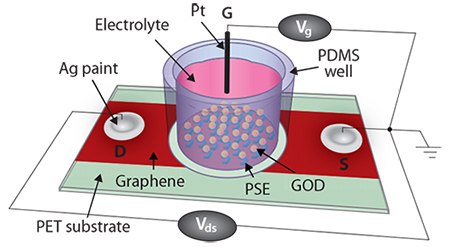
Figure 5.CVD graphene-based FET biosensor. Adapted from Reference 32.
Furthermore, large area graphene grown by CVD was shown to be capable of detecting the electronic activity of electrogenic cells with greater sensitivity due to the higher charge carrier mobility and chemical stability of CVD graphene.33 The interaction of CVD graphene films with neurites during their maturation was investigated in a mouse hippocampal culture model.34 Graphene films had excellent biocompatibility, and promoted neurite sprouting and outgrowth. As a consequence, graphene could be a very promising material for cellular-interfaced sensing devices in neuroprosthetic device applications and recording electrogenics activity.33,35
Graphene Films in Biomolecule Investigation Under TEM/HRTEM
Transmission electron microscopy (TEM) and high-resolution transmission electron microscopy (HRTEM) allow the investigation of many different molecules. Existing TEM supports have certain limitations when examining nanoparticles, biomolecules, and biological materials due to interferences coming from the platform. Ultrathin amorphous carbon films (2-3 nm thick) contribute to the overall electron scattering and diminish the contrast of low atomic number specimens.36 This can be overcome by using atomically thin and highly conductive continuous monolayer graphene membranes produced via CVD (Figure 6), since they should not interfere with the analysis of the molecules. Graphenebased membranes would be useful not only in static imaging with atomic resolution, but also in the atomic level visualization of dynamic phenomena such as thermally activated desorption, drift, and diffusion processes.37 Graphene was used as an ultrathin support for the direct imaging of the organic capping layers and interfaces attached to gold nanoparticles.36 In another study, graphene flakes were used as TEM support material to study tobacco mosaic viruses (TMVs).38 High contrast was obtained without the need for staining the TMVs.
Conclusions and Future Perspectives
The versatile chemistry of graphene-based nanomaterials including the capability to conjugate with water-soluble and water-insoluble active compounds, DNA, proteins, cells, targeting agents, polymers, and even nanoparticles make them desirable nanoplatforms for future biomedical research. GO has emerged as an extremely interesting material for drug and gene delivery, molecular imaging, and optical biosensor applications. Functionalized GO has been proven to be biocompatible, and when combined with therapeutic agents and targeting strategies, it could lead to improved diagnosis and treatment for a variety of diseases, including cancer. CVD graphene films have emerged as the material of choice for future tissue engineering applications due to their flexibility, atomic thickness, versatility, and unusual properties. The proliferation and differentiation of a number of stem cells have indicated graphene films could become the next scaffolding material. In addition, CVD graphene films were found to be very suitable in FET-type biosensors due to their high sensitivity as a result of their high electronic mobility. These films were also found to be ideal supports for imaging nanoparticles and biomolecules under HRTEM. rGO based electrochemical biosensors were also found to perform very well. However, before graphene and its derivatives can be applied in biomedical/ bioelectronic applications, extensive in vivo trials will be required.
As a future perspective, recent work has demonstrated the unique capability of graphene to confine light in extreme sub-wavelength spots. This opens up the possibility to develop antenna-based ultrasensitive biosensors using graphene plasmons, where the effective probe volume is on the order of a few tens of nanometers.39 The combination of biology and nanoelectronics could lead to the development of smart neuroprosthetic devices capable of sensing and stimulating at the same time. CVD graphene films interface very well with cells and thanks to their high charge carrier mobility and potential to modulate the charge carrier density, they could have a great future as implantable functional materials.
The fate of graphene and its derivatives in biotechnology is difficult to predict. However, due to their extraordinary characteristics, they have emerged as extremely promising and versatile materials. Nevertheless, the convergence of multiple disciplines will be required for more progress in this research. Ultimately, progress could lead to multifunctional smart
Materials
References
如要继续阅读,请登录或创建帐户。
暂无帐户?